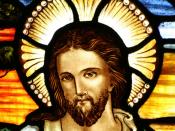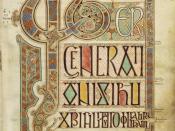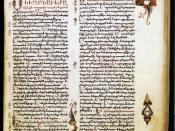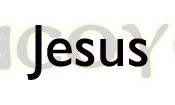Introduction:the overall story of ''The Power and The Glory'' is organized under the number four. The book is divided into four parts, three of those parts are clearly divided into four chapters, while the last part is composed of four sub-parts which are not numbered, but clearly separated by four paragraphs. What does these systematic divisions and subdivisions in four mean?We have to consider two possible interpretations. First, the number four corresponds to God's divine order. At the beginning God, whose name has four letters ''YHVH'', created the four elements, the four rivers, the four winds, the four seasons, the four dimensions (length, width, height, and time) and the four points representing the four directions (the cardinal points of a compass). We should not forget that the anonymous priest explores all directions and all borders of his province (the harbor, the mountains, the rivers, and the forests) to escape or to find shelter.
The universal message expressed in the four cardinal points is reflected in the four branches of the cross, symbol of Jesus Christ's martyrdom and also symbol of the fugitive priest.
Secondly, there are four Gospel accounts in the new testament: ''Matthew'',''Mark''',''Luke'', and ''John''.
There are traces in different proportion of the four Gospels in the ''Power and the Glory''. Even if it remains difficult to match each part of the novel with one of the Gospel, the fact is there, the Christ's message is entirely contained in these scriptures and by the the presence of the four Gospels in Greene's novel, the book becomes a modern bearer of the biblical message. Whatever the catholic heterodoxy that Greene had, the endorsement of the Gospel message appears to be written down in the very structure of the novel.
If the novel's architecture is in a visibly quaternary sequence, it is essentially because the number four allows for additions, associations, and connections two by two. Thus, the first and last parts go together to frame the main story and to create a sort of introduction and conclusion to the novel. Between the beginning and the end, we have an effect of symmetry that is expressed by the appearance of the same secondary characters.
In the same time, the second and the third parts form a whole in the novel, a central body of the story.
Again the idea of duplication and duality is underlined by the presence of the priest and thelieutenant which occupies the front of the stage.
All these mirrored effects emphasize the depth of the functioning logic of the novel, therefore they deserve a detailed analysis.
Part 1:In the first part of the novel, when looking at the chapter's four titles, we have ''the Port'', ''the Capital'', ''the River'',and ''the Bystanders''. The titles refer to places and people, surroundings (settings) and characters. The last title ''the Bystanders'' clearly indicates the subordinate or the secondary nature of the characters presented in the novel. The key, here, is in what the characters are attending and witnessing in the novel. And we can definitely see that it is through the secondary characters that the hero of the novel is presented to the reader. [The third-person omniscient]It doesn't mean that the secondary characters are not important, but that they constantly have a double function; they express their own feelings and they present the main character of the novel.
The first three chapters introduce for the first time all the witnesses and the fourth chapter shows them a second time in a movement of repetition and synthesis.[1+4]The four chapters at the beginning help to approach, surround, identify and announce the main character. Right at the beginning, we can see Greene's paradoxical art which consists at the same time in describing the surroundings and the inhabitants while highlighting a passing shadow. There is a character that the reader found everywhere in the beginning, even if he is represented like a blurred outline (or sketch), he catches the reader's eye. And he is the character who ensures a sense of unity in the novel. He is not mentioned in any title but he appears everywhere, he is never preeminent but we can only see him. While exiling the main character at the periphery, Greene succeeds in placing the priest at the center of the story at he beginning.
Part 4 :in the final part, the hero is no longer a mysterious shadow, because he had been in the limelight for two long parts he had become a genuine character. In the sense that the reader has accompanied the priest in his remorse, fears, prayers, humiliations, his acts of courage and cowardice. So the reader expects to attend the last scene next to the priest. (the priest = the emotional and reading anchor)Yet, nothing like this happens in the last part, where the hero is only a subject of discussion or description.
In contrast to the first part where everything is done to generate the interest and the curiosity of the reader towards the anonymous priest. The last part seems to apply a strategy of frustration for the reader and to create a distance between the reader and the main character.
Pb: how to consider or interpret the creation of a gap between the hero and the reader?The relegation of the main character into the background aims to divert the reader interest from the only story devoted to the priest.
This technique allows the reader two things:a critical stand back (difficult to judge a character when you are attached to it)and to prepare room for the arrival of the coming priest in the end.
The whiskey priest must stop appearing as the hero to allow the new priest to come out as a new hero.
The execution of the whiskey priest should not be read [red] like a final event, since the conclusion is not an end (a closing act) but an opening (overture), a renewal (a new beginning), ''history is constantly repeating itself''.
In the end the whiskey priest is seen as a simple man like many others, an other victim of the prevailing order. The anonymous priest leaves the main position of the novel in vacancy. And this vacancy being immediately filled by the new priest shows that the story is set in a logic of repetition and renewal, and not in a logic of completion (achievement).
Part 1+ Part 4:When the same characters appear in the first and last parts, and that they are presented to the reader the very same way, the idea of a structural circle is predominant in the novel. The creation of a mirrored effect between the first part and the last part leads to the concept of circular pattern in the story.
Pb: How does this architecture of recurrence appear in the novel?simply by the repetition of words, actions and situations.
Mrs Fellows, for example, that the reader meets for the first time laying down on her bed with a terrible headache under a mosquito net, is in the exact same position in the final part: [p.211] ''Mrs Fellows lay in bed in the hot hotel room''.
[p32] ''I tell you I had fever, Mrs Fellows wailed, I felt so terribly ill''.
[p32] ''I had such a headache. I couldn't read or sew''.
[p52] ''My darling, I've got such a headache''.
=[p212] ''I must get up later and pack, but my head hurts so''.
[p212] ''My poor head''.
[p212] ''I sometimes think it's more than a headache''.
[p33] Mr Fellows: ''He sat down on the bed and put his hand upon her arm''.
=[p211] Mr Fellows: ''He came across to the bed and laid the handkerchief over his wife's eyes. Then sitting down on a chair, he slipped his hand under the net and felt for her hand''.
Mr Tench, the dentist with his fading memory seems to keep a painful stomach from the beginning to the end.
[p7] ''An awful feeling of nausea gripped Mr Tench in the stomach''.
[p8] ''He was shaken with nausea ...-something was wrong- worms, dysentery''.
[p10] ''He put his hand on his stomach and said, you haven't got any medicine, have you, for ÃÂ oh hell.
I don't know what...you can't cure me no one can''.
=[p214] ''It's indigestion, Mr Tench said. Sometimes I have so many spots in front of my eyes I might be wearing a veil''.
[p215] ''He belched and put his other hand against his stomach, pressing, pressing, seeking an obscure pain which was nearly always there''.
[p215] ''Of course, it's nothing. Just indigestion. But it gets me locked''.
[p216] ''With his hand on his stomach he protested ...not another revolution''.
Luis's mother goes on reading the same story about Juan the martyr to her children. Her daughters continues to listen to it and to stare at her with wide eyes. Between the first part and the last part, we have the repetition of the words ''Beady eyes'', [p26] ''The two little girls sat with beady intense eyes'' = [p217] ''the two little girls with beady eyes held their breath'', and the girls have the same feeling at evocation of the whiskey priest [p27] ''The smallest girl said suddenly, he smelt funny'' = [p219] ''He had a funny smell, one of the little girls said''. All this shows us how nothing had changed in the hotbed (foyer) of apprentice (novice) religious zealots (bigots).
For some characters in this novel, there is no space for change when for example the Fellows and Mr Tench want too flee Mexico in the end, their attempts are doomed to failure. The characters are trapped in a vicious circle, and there is no space for change or for escapism (for them).
Ultimately, these repetitions and loops in the novel refer to a circular pattern, it is essentially because the novel is built to illustrate the idea of circles of hell from which mankind can not escape.
{the parallel of the frame work of the first part and the last part of the secondary characters acts again as an almost religious affiliation, their lives are funneling down in their personal circles of hell}.
Greene's characters are confined in a space which is narrowing on itself. And only the chosen one can escape from those vicious circles. For example, Luis is not trapped in a repetitive logic. At the beginning he is fascinated by the power of the lieutenant, but in the final part he realizes that this power only brings destruction and is responsible for the disappearance of the revolutionary heroes. When he associates heroes with priest, his evolution is accomplished (achieved). And then, he is worthy to receive the holly grace and to witness the miraculous arrival of the new representative of God.
The novel established a contrast between a circular imprisonment of mankind stuck in his condition and the blessed sacred metamorphosis of the human being touched by the grace.
Transition 1/4 to 2/3:between parts 3+4 and parts 2+3, we have a different system of focalisation.
Parts 1+4 presented a portrait of several characters with smaller personal stories (except for one paragraph which is devoted to the priest). On the contrary in parts 3+4, the narrative focuses on the priest whose point of view is largely dominant, as well as the lieutenant.
Between 1+4 and 3+4 we have a restriction or a narrowing in the field of focalisation.
Parts 3+4 offer a more concentrated story on the priest and his opponent.
Part 2:In part 2, the priest journey is made of anarchical trips and retraced path. The priest zigzags through the whole state and this gives an image of restlessness to the novel.
There is not a single place in part 2 that the priest hasn't been to, ie: ''the Capital'',''the Fellows' house'',and ''Maria's Village''. After ten years of getaway, the priest knows each corner and hideaway in the state.
Moreover, the distance between the priest and the lieutenant, the hunted and the hunter, decreases and increases, decreases and increases throughout the 2scd part. A tracking tempo settles in the second part giving rhythm to the chase. This disjointed rhythm moves the 2scd part into a traditional thriller. Ie, the manhunt is already there with the juxtaposition on the police station's wall of the picture of the priest with the picture of the Gringo. The lieutenant's technique to catch the priest seems to be unstoppable and foolproof. At the beginning the reader doesn't rate the priest chances highly, but as we go along the story the reader starts to believe in the priest's special/unusual destiny, who ends up escaping the lieutenant miraculously each time.
Part 3:On the contrary in the 3rd part the thriller style is abandoned. The priest found shelter at the Lehr's house which is set in a sort of No Man's Land (not a very defined location, in between two states).
During his stay of several days at the Lehrs, the priest enjoys some time off, some rest, and it is a time reflexion. He regains strength, confidence and faith. (we have to keep in mind that no one knows that the Police is after him). After the zigzag of the manhunt, this part structurally represents a continuous line. The tension decreases and the rhythm goes down. After a time of action comes a time of meditation.
And when finally the action is back again with the appearance of the Metiso, the priest has already made his mind: he leaves his fugitive role to slip on a martyr role.
[the priest turned his mule back], his turn around sets up a breaking point in the novel, since the course of the priest is retraced backward. The return to the Capital is no longer anarchical, it is essentially linear.
The 3rd part creates an identification of the priest with Jesus Christ: the priest destiny meets the stations of the cross.
-the priest is left alone before his execution and during his resurrection. (''there was no body there'').
-Juda//Metiso.
-christ et barabbas // the priest and the gringo (two convicts or runaways)Conclusion:the 2scd and 3rd parts echo and complement each other.
The 2scd part emphasizes on the thriller style and focuses more on the physical destiny of the priest.
While the 3rd part tends to imitate the life of Jesus Christ and focuses more on the spiritual destiny of the priest.
The Power and The Glory, Graham Greene.





